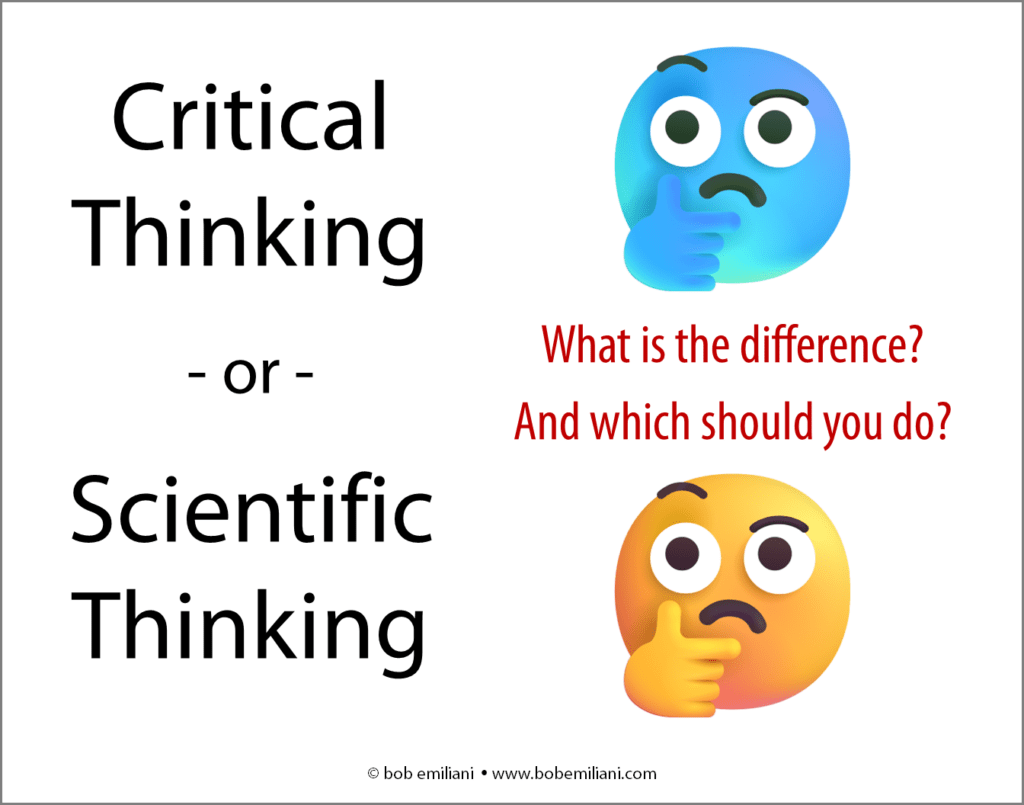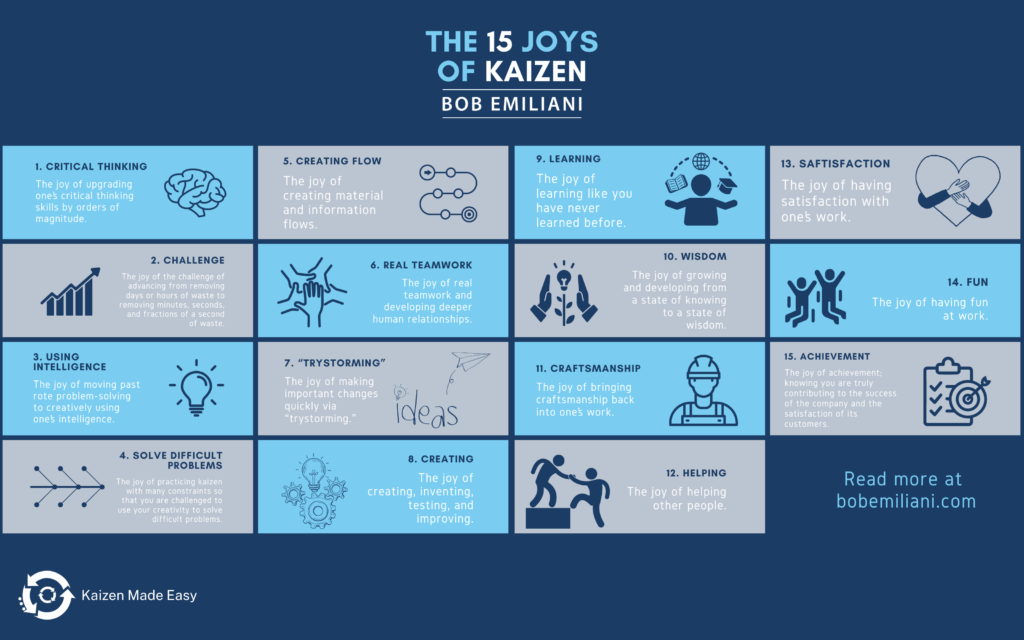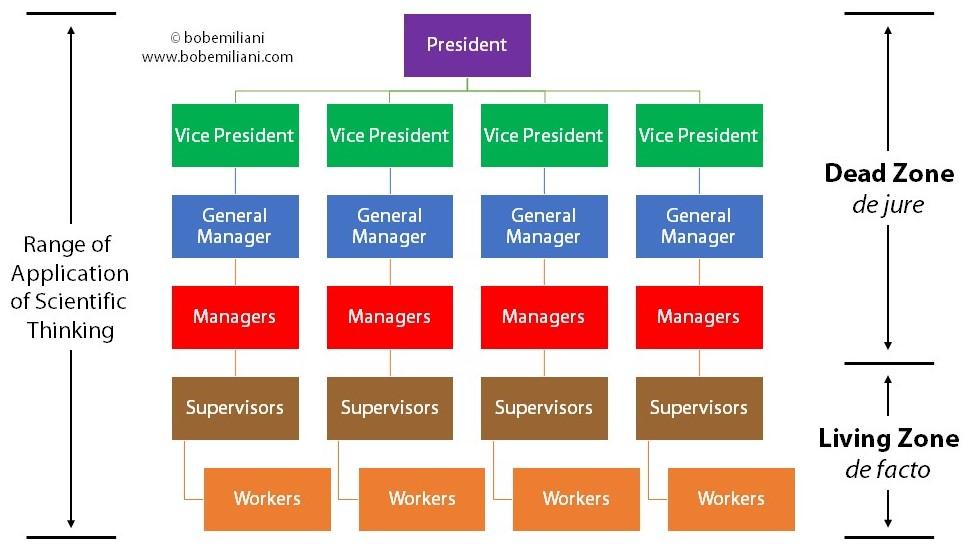Critical thinking or scientific thinking. What is the difference? And which should you practice? Let’s begin with definitions of these two cognitive skills:
“Critical thinking is the intellectually disciplined process of actively and skillfully conceptualizing, applying, analyzing, synthesizing, and/or evaluating information gathered from, or generated by, observation, experience, reflection, reasoning, or communication, as a guide to belief and action.” (Source: The Foundation for Critical Thinking)
Scientific thinking is a generalized application of a critical thinking process called the scientific method, a six-step process (observe a problem, form a hypothesis, design an experiment to test the hypothesis, collect data, analyze results, and draw conclusions) to understand and explain phenomena for the purpose of knowledge seeking and knowledge building. Historically, scientific thinking, comprising curiosity, skepticism, objectivity, evidence-based reasoning, logic, analysis, and openness to revision, precedes the scientific method by 200,000 years or more.

In terms of hierarchy, critical thinking stands above scientific thinking. All scientific thinking is critical thinking, but critical thinking is not scientific thinking. Critical thinking is reflective and includes awareness of one’s own thinking (including biases and assumptions; i.e., metacognition, awareness and understanding of one’s own thought processes) with the goal of being as objective as one can be. That includes interest in analyzing multiple perspectives and the rigorous evaluation of counterarguments.
Scientists must be critical thinkers, but one does not have to be a scientist to be a critical thinker or a scientific thinker. It can be viewed in this way: the scientific method is a single reasoning method for a narrow context, while critical thinking comprises many different reasoning methods applicable to wider contexts. A critical thinker dissects information using logical reasoning as their method for constructing their ideas and arguments. A scientific thinker uses verifiable empirical evidence as their method for constructing their knowledge and for problem-solving.
Critical thinking has broader applicability than scientific thinking. It is applied to art, philosophy, sociology, politics, history, ethics, business (e.g., management decisions), etc. Despite being a subset of critical thinking, scientific thinking and critical thinking are complementary to one another. While their purpose differs, both types of thinking use logical reasoning to produce conclusions and strive to avoid bias.
In broad, but not definitive terms, one would use scientific thinking to improve processes on the shop and office floor where evidence and experimentation are especially important. But for leadership and management problems, one would use critical thinking. Critical thinking would ask, “Is the process necessary?” whereas scientific thinking would ask “What is wrong with the process?” or “How can the process be improved?” Sometimes there is overlap, which is common if one learns Toyota-style kaizen.
How do you learn critical thinking and scientific thinking? Every teacher, from grade school to graduate school says their primary objective is to teach students how to think critically. In courses that teach one of the many disciplines of science, teachers have as their main objective to teach students the scientific method and thus major elements of scientific thinking — curiosity, skepticism, objectivity, evidence-based reasoning, logic, analysis, and openness to revision. If practiced regularly, scientific thinking can become habitual.
However, we know from experience that most people are better at scientific thinking than critical thinking. Scientific thinking has brought great discoveries and improvements to the material world, and the capability to solve some important current and future problems. Critical thinking, however, is more challenging, as evidenced by the many chronic economic, social, political, philosophical, spiritual, business, legal, and aesthetic problems that recur or go unsolved for vast stretches of time. In general, teachers struggle in their mission to teach critical thinking such that that students retain the cognitive skill post-graduation, partly because it is difficult and time consuming and takes unrelenting determination and drive. But the more important factor is social dynamics, which are so effective at thwarting or diminishing the desire and ability of individuals and groups to think critically.
Despite this, there are many individual critical thinkers in the lower ranks of society, an organization, or group (myself included). They are efficient producers of insightful and trustworthy critical thinking, but what is production without distribution? The distribution that counts is not the LinkedIn, TikTok or Amazon, but people — and not the people who occupy the lower ranks of society, an organization, or group. Distribution of critical thinkers’ work is modulated by those highest in status in society, an organization, or group. If they like it, they talk about it and promote it. If they don’t like it, they disregard it completely or actively work to shut it down (now you know why all the high status Lean people ignore [and privately scorn] my work 😉).
In any company, scientific thinking is practiced by necessity among people in the lower ranks of the organization to “do a good job,” to remain employed, and to be a candidate for advancement. Despite the applicability of scientific thinking to all levels of the hierarchy, those at mid-level and higher increasingly gain the privilege to make decisions by right (de jure). They do make decisions based on facts (de facto), but usually only when the facts are convenient in relation to their business or personal goals. Leaders promptly dismiss inconvenient facts by right, as it is their privilege to do so.
Of course, there are always some very good critical thinkers in any company, yet when they offer their insights to leaders they are typically shut down quickly, the facts being so inconvenient and distressing, if not insulting. The message from the boss is clear. But some people do not listen or cannot listen, driven by the need to understand why circumstances are so illogical. Do enough critical thinking and the person will surely suffer unpleasant consequences, sooner or later.
The de jure–de facto divide is something that should not exist, but it does. It is the result of status and hierarchy, which itself is not so bad, as humans seem to need them (at least for now). It becomes a question of how status and hierarchy are used — to maintain the status quo for a few, or improvement for many. If it is the former, then de jure–de facto divide will remain. If it is the latter, then the de jure–de facto divide must be reduced. And the closing of this gap will be situational rather than ever-present because leaders will not give up their treasured status, rights, and privileges.
For more than 35 years, people have sought to engage leaders in genba kaizen. Most are unsuccessful because participating in kaizen reduces leaders’ status and exposes then to facts that they would rather not know. Kaizen is the work of lower-level people, in their view. But, in cases where leaders have participated in kaizen, they begin to think more scientifically, and sometimes that carries over into their thinking about how they lead and manage people and processes.
But the more important effect of leaders participating in kaizen is that it can — depending on the facilitator and number of their kaizen experiences — improve their critical thinking skills. And that is a huge change because it carries over into how they think about the business and its relationships with stakeholders. We have evidence of this from CEOs such as Art Byrne, Gary Kaplan, George Koenigsaecker, and others.
In a post titled, “The 15 Joys of Kaizen,” I cited critical thinking as the top benefit because from that flows the other 14 joys. Genba kaizen, done right, teaches both critical thinking and scientific thinking. That’s why I have long advocated for kaizen in preference to the “Lean tools,” including kata.

In 2009, Mike Rother’s book Toyota Kata, was published. Since then, he has been on a mission to bring scientific thinking to whomever wants it. It is a noble quest, one that he will likely pursue for as long as he can, with the strong support of Jeffrey Liker and other high status people and groups. But as I mentioned above, scientific thinking has limitations that critical thinking does not.
Mike has suggested adding kata to bad Western kaizen practice in order to improve it. I disagree. That is a solution in search of a problem. The solution should instead be to teach people the fundamental method of process improvement, genba kaizen; the proper way to practice genba kaizen (Toyota-style kaizen) to simultaneously develop both critical thinking and scientific thinking skills and experience the many joys of kaizen. Today, so-called Lean tools have become part of the problem-solving toolkit of almost all classically managed businesses. It is a mistake to continue to focus on Lean tools, as they themselves have become a major problem.
The reason why kaizen and the critical thinking that comes from it is so important is because it can be used to analyse and solve problems that are external to the domain of scientific thinking. This includes complex problems such as the brand power of classical management, as well as the myriad chronic social, economic, political, philosophical, spiritual, business, legal, and aesthetic problems that afflict businesses and societies around the world. Scientific thinking falls into the bias trap if people believe that it can solve the problems that critical thinking is better suited to solve.
Scientific thinking is great for solving the process and related types of problems that exist in the lowest levels of an organization, but we must understand its limitations and for what scientific thinking is in service to in the context of business. Only critical thinking can solve the really big problems. Thus, humanity needs more critical thinking than scientific thinking — notwithstanding the distribution problem described previously, but which might be overcome by generating a much larger a mass of critical thinking. Kaizen can help with that.
SIDEBAR 1: Critical thinking starts from the position “whatever is, is wrong.” Scientific thinking may start from the position “whatever is, is wrong,” but it is more likely to start from the position “whatever is, is right,” with an eye towards learning why it is right. The difference can be profound.
SIDEBAR 2: Scientific thinking is fundamental to human evolutionary history. Early humans living in the natural world were curious and sought to question and understand the patterns (rhythms of life and nature) as well as cause and effect relationships for their survival. Scientific thinking led to the neolithic revolution; the development of agriculture, animal husbandry, and civilizations. Curiosity, skepticism, objectivity, evidence-based reasoning, logic, analysis, and openness to revision are fundamentals of scientific thinking. So that raises some interesting questions: Is scientific thinking evolutionarily ingrained in human thinking? Is it necessary to teach scientific thinking? When and why did it become necessary to teach scientific thinking? Is the necessity for teaching scientific thinking most acute in organizations due to the existence of hierarchy, status, and politics? Or, as humans have advanced and modernized, did the necessity for scientific thinking decrease and thus lead to a call for its renewal? Will advancements in computing (i.e., artificial intelligence) diminish human ability to think scientifically — to be less curious, less skeptical, less objective, less reasoned, less logical, less analytical, and less open to revision? It will be interesting to see how this unfolds, as well as the future role and impact of critical thinking which might further grow in importance, and may someday lead to a second Age of Enlightenment.

